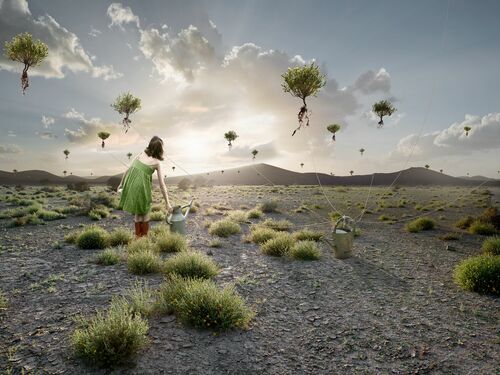1. Your works are often magical, like a fairy tale world. Where do you get your inspiration from? What are the main topics you are focusing on recently?
As a kid I was always inventing things, just for the fun of feeling different and independent from virtually everything. So I immediately fell in love with the surrealists. For my photography, I just added a touch of poetry and pathos from of my French childhood. I get my day to day inspiration from the sheer beauty surrounding us, but seen through the eyes of the child I have remained.
Staying focused on a specific topic is very difficult for me since the images are exactly the opposite, a sort of wander through life in a constant search for some form of meaning. So I do the opposite, I take pictures, assemble them, and then try to seek something more profound. I then constitute a series.
So for the moment the emerging series is about nature, the animal world and our interaction with them.
Funny how this follows with the next question – how did you know ???
2. Many of your works are shot in nature. What do you think of the relationship between man and nature? What do you think is the ideal relationship between the two?
That is a very difficult question that today needs a simple comprehensible answer. My answer is that I think that mankind just cannot understand nature. It is way beyond him. Our brains are simply not sufficient. Sometimes I wonder whether this explains our aggressiveness, and yet our immense admiration towards nature. As for the ideal relationship, it is easier to see, as I tried to show with the series “A small world”: a strictly non-aggressive attitude and a true ecological behavior as I will explain later.
3. The topic of this issue of our magazine is "dependence". What do you think of the relationship between people and animals or pets? Have you ever expressed your ideas through your work?
The answer is straight-forward for anyone who has really looked at his cat for hours and hours on. And strangely, the same answer can be found when reading recent research work. Every other day we learn that X or Y species is capable of feelings, empathy, pain, communication or you name it… and every other day we have to acknowledge we are not so special after all. It’s a huge and profound change that is operating in which we are realizing who really is dependent on whom.
Yes, a few pictures deal with this relationship and the way mankind imposes his view to the detriment of the animal kingdom. Several pictures depict the different time and space scales between us and the animal world. Others show very caring mutual relationships like between wolves and humans and how their common space should be shared. The series I’m working on now is more about what we should do to remedy the situation.
4. What kind of World is your series "A Small World" about? Can you describe it for us?
“A Small World” depicts landscape scenes from a tender and mischievous perspective. With this series I am trying to show how the limited nature, of our world and ourselves, contradicts with our seemingly unlimited imagination. This ties in with one of the ultimate issues of ecology: not to physically appropriate nature as is too often the case today, but to represent it through reflection and imagination, through a strictly non-aggressive act.
A landscape image is therefore not a finality but the start of a process, to introduce dream into the realm of the ordinary. The photographer is no longer just a passive observer as he is a player in his environment again.
Again I like to treat subjects with a lot of lightness to give a feeling that things are really possible, and sometimes even better, through imagination… !
5. Who is Lucida in Camera Lucida? Why choose such a protagonist? What kind of story did you tell?
Note: Dear author of the question, well… we all have issues with translation and non-native languages but your question might show some form of mis-understanding, which in fact turns into a really really good question. In fact Camera Obscura is a darkroom, the precursor to the camera. I saw no reason why – in my imagination world – the room could not be a lightroom (LightRoom by Adobe came out after my series) in a dark or obscure world. That’s why Camera Lucida. So I respond with some humor, which your readers will surely appreciate…
Camera Lucida is Latin for the “Light Room”. She is the sister of Camera Obscura, the Latin name for the “Dark Room” which became when she grew up into a respectful grand’ma, the well known “camera”. Camera Lucida, as a protagonist, was full of mischief, always saw things which were not to be seen, always imagined the end of every story, every scene, every landscape. She saw magical ideas everywhere, while her sister Obscura, always stuck to the book to become a famous photographer. No one knew why Obscura became famous, and not Lucida, and yet, joy of life was the essence of Lucida. And still today, it’s the light in Lucida that keeps Obscura alive. Lucida told stories of the world, the sun, sky, rain, moon and other elements in her own way. Lucida invented original staging ideas like multiple objects suspended in the sky, which were later taken on by Obscura so as to appear creative, but in the meantime Lucida had already moved on to something else. Lucida is a shooting star. Lucida tells tales like this one.





